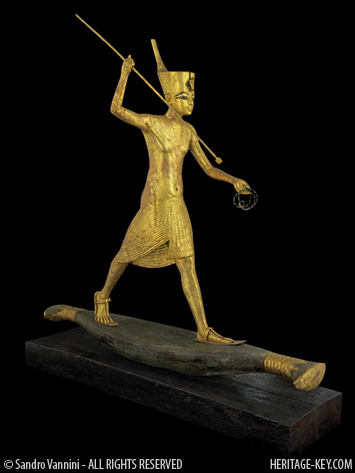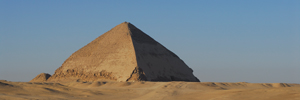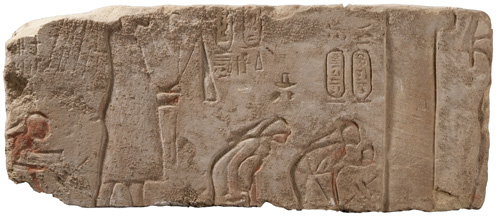 When Egyptologist Kei Yamamoto excavated The Terrace of the Great God at Abydos he came across a collection of curiously-fashioned goblets. Were these bottomless vessels evidence of the builders’ reverence to a remarkable place of ancient worship?
When Egyptologist Kei Yamamoto excavated The Terrace of the Great God at Abydos he came across a collection of curiously-fashioned goblets. Were these bottomless vessels evidence of the builders’ reverence to a remarkable place of ancient worship?
3,800 years ago, during the Middle Kingdom period in Egypts history, there was a temple to Osiris at Abydos. Nothing of it survives today, but based on the location of later temples, archaeologists have a rough idea of where it would have stood.
They also know that just in front of the Osiris templewas an area known in the Middle Kingdom as the Terrace of the Great God.
This area contained numerous chapels built by private citizens (not royal kings) for worship. People wanted their chapels to be as close to the Osiris temple as permitted and as such numerous chapels were bunched together on a narrow stretch of land.
Its like being at a concert,Egyptologist Dr. Kei Yamamoto said, you want to be (in) the front seat.
Dr. Yamamoto has excavated three of these private chapels as part of his PhD dissertation work and is trying to raisefunds to continuethis work. He has discovered evidence of an ancient ritual underneath one of the chapels. He has alsofound evidencethat an Egyptian king, Senwosret I, engaged in some bulldozing in an attempt to create a new road for religious processions.
Dr Yamamoto presented his findings at a lecture at the University of Toronto campus two weeks ago, and kindly granted Heritage Key a follow-up interview, where he discussed his work in more detail.
 A Ritual Based on Goblets
A Ritual Based on Goblets
Chapel two, the remains of which are pictured above, had an altar, a small mud brick arch-dome and a mud plastered floor.
It dates back nearly 3,800 years to the 12th dynasty of Egypts Middle Kingdom.
The most important finds were underneath the surface. When Dr. Yamamoto excavated the areaunderneath the mud plastered floors he discovered nearly 50 broken goblets with stoppers. They were all buried in a layer of sand.
One of the goblets is pictured here with its stopper on top. Each of the goblets would have held some sort of liquid which has long since evaporated.
Dr. Yamamoto believes that all the goblets were deliberately placed in this layer of sand when the chapel was being built. It was done for some sort of ritualistic reason possibly as an offering to protect the chapel from destruction.
If that is the case the ritual ironically worked, at least in a sense.
Chapel two is one of the best preserved of the Middle Kingdom chapels today and its state of preservation is one of the reasons why Dr. Yamamoto dug it up.
Why Were the Goblets Made by Hand?
Another aspect of this discovery is the unusual nature of the goblets themselves. Their construction is such that they are not very practical as cups – you can’t put one down on a flat surface without the contents spilling out. The only way to preventthisis to stickit in the soil. These gobletsare found in abundance at Abydos, but are rarely found outside of that site.
 Another odd thing is that all the goblets Yamamoto found were made by hand in a rather crude way. This is unusual because, by the Middle Kingdom era, Egypt had a sophisticated pottery tradition. They had the potters wheel and an industry where specialists (mostly men) devoted their working hours to making pots. If the goblets were made by these specialists, they could have made them in a more aesthetically pleasing way.
Another odd thing is that all the goblets Yamamoto found were made by hand in a rather crude way. This is unusual because, by the Middle Kingdom era, Egypt had a sophisticated pottery tradition. They had the potters wheel and an industry where specialists (mostly men) devoted their working hours to making pots. If the goblets were made by these specialists, they could have made them in a more aesthetically pleasing way.
Dr. Yamamoto told Heritage Key that he cannot rule out the possibility that the decision to make them by hand has something to do with the ritual they were used for.
(Its) hard to get into the mind of ancient Egyptians, he pointed out.
A more likely scenario, and the simpler one, is that they did it for economic reasons. Perhaps the people who built this chapel could not afford to have these goblets professionally made and did the work by themselves or by someone else who did it more cheaply.
In any case the people who built this chapel were determined to carry out this ritual, even if that meant making the goblets by hand.
Other Examples of Foundation Deposits
Dr. Yamamoto said that it is extremely rare to find this sort of foundation deposit in a private chapel. There is only one other case on the terrace, dug up decades ago, that resembles it.
Foundation deposits are more common in royal buildings that is structures built by the pharaoh. These deposits generally have higher quality goods such as properly made pots, scarabs and other ceremonial items. It is believed that these royal deposits were used to protect buildings from harm.
 Ancient Bulldozing
Ancient Bulldozing
When Dr. Yamamoto explored the surface beneath the remains of the other two chapels he found evidence of what appears to be ancient demolition.
These chapels date to the late 12th/early 13th dynasty and, as such, are slightly younger than the chapel with the goblets underneath. When Dr. Yamamoto probed the subsurface of these chapels he found that they stoodon top ofabout 1.5 meters of rubble brick remains.
To find out what these brick remains originally were – Yamamoto broke some of the bricks apart so that he could get to the scraps of pottery inside them.
The pottery that he recovered dated to the early 12th dynasty. He also found that the bricks were of a non-royal type (bricks used for royal projects in Ancient Egypt have a specific measurement).
His conclusion the rubble layer underneath the two chapelsare the remains of older private chapels that had been destroyed.
Furthermore these destroyed chapels originally existed slightly to the north.The remains were dumped on the current site. Just likehow a construction worker today, while demolishing a building, would move the rubble toa different location.
Who Destroyed These Chapels… and why?
The most likely candidate for the destroyer of these chapels is Senwosret I – the Middle Kingdom Pharaoh who reigned in the 20th century BC.
I believe that he was clearing the area just outside the temple precinct so that he could build a new, nicely paved, mud plastered road that was going to be used for the procession of the god Osiris,” said Yamamoto.
He added that evidence for the road has been found archaeologically and Senwosret Iis known for being heavily involved in the cult activities at Abydos.
Over time sand encompassed this rubble layer and, long after Senwosret I was dead, people built new chapels over it.



